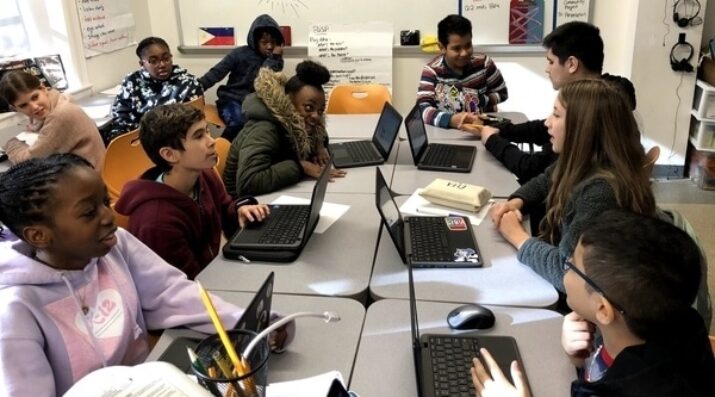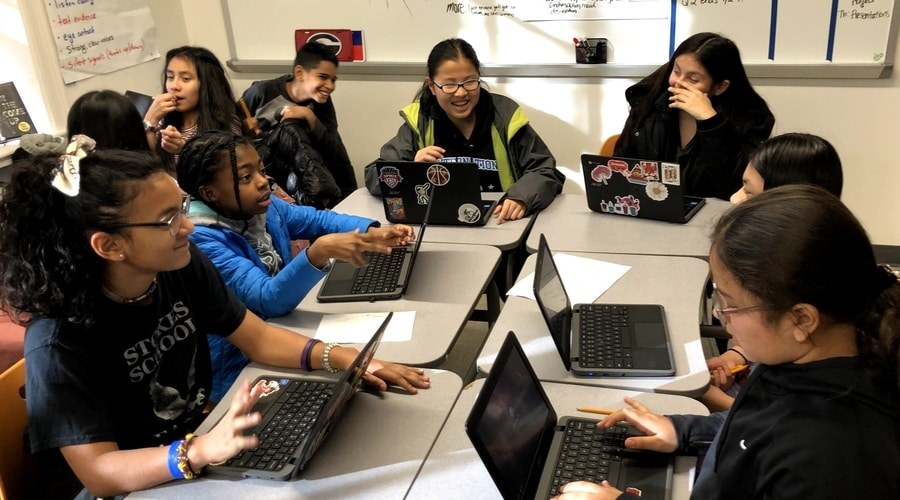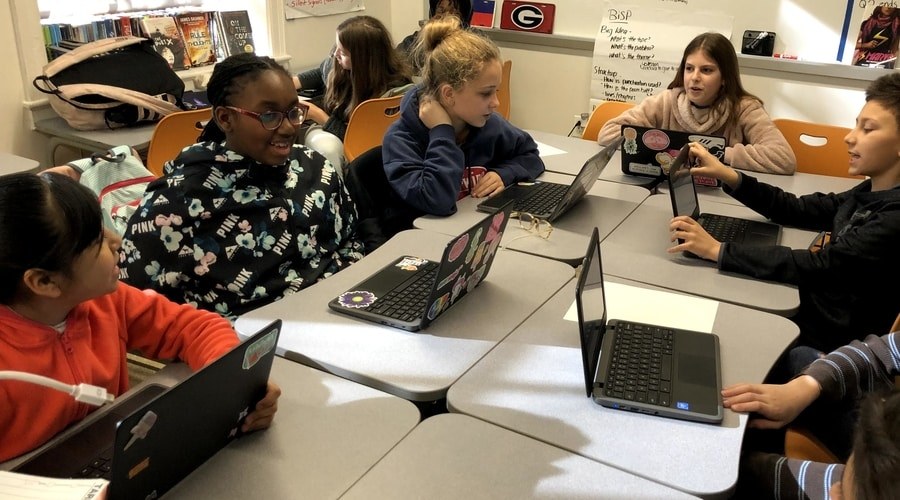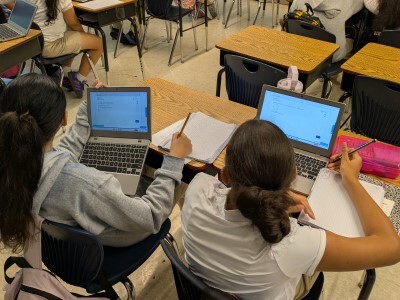Student-Led Group Discussions: Everyone Learns
Topics

We’ve all had the experience of truly purposeful, authentic learning and know how valuable it is. Educators are taking the best of what we know about learning, student support, effective instruction, and interpersonal skill-building to completely reimagine schools so that students experience that kind of purposeful learning all day, every day.
Students take on more responsibility when teachers provide the opportunity. One example: students leading small groups in rigorous literary discussion.
Several years ago, I received an important piece of feedback from an instructional coach. While my instruction was generally going well, she noticed that most of my lessons were teacher-directed. My students, a diverse group of DC sixth graders, were ready to take on more responsibility, but I wasn’t providing that opportunity. As a result, I began delegating some of the “teacher work” to responsible group leaders. These group leaders excelled so much at “being the teacher,” that soon every student in class had the opportunity to lead a small group in rigorous literary discussion.
This year, my teaching team decided to expand this process into a group-paced two-week mini-unit. We broke a quarter-long unit down into three manageable sections. In the first month, we read and discussed a book together in a more traditional English-class way. Our target skills were characterization and theme, but we also practiced close reading skills more broadly using transferable questions that could apply to any narrative text, like “How is the problem developing? What are we learning about the characters? What is the central idea?” Then, we continued practicing these skills, but in small, student-directed groups using short stories. Each group moved at its own pace through a predetermined set of tasks. In the final stretch of the unit, students took a test in which they independently read a passage, answered multiple choice questions, and wrote a theme paragraph. After that assessment, they participated in a graded “Fishbowl” discussion on the themes of the unit.

Courtesy of Emily Culp
What did it look like to hand the reins over to students during that middle unit? Students completed this EdPuzzle lesson that introduced the new unit. In this launch lesson, students learned the unit basics. Their group would be assessed both on work completion and collaborative skills. In terms of work, students had four concrete, observable tasks to complete. Whenever they collectively completed the first set of tasks, they had another at-bat with these four tasks using a different narrative.
Some group leaders excelled. Others struggled. All learned.
Meanwhile, group leaders were selected and given expectations for how to lead the group in a short story discussion. Leaders read the text in advance and reviewed the pre-prepared transferable questions. The next class, leaders acted as the teacher voice, explaining the purpose of reading, stopping to ask questions, and probing for evidence. (For example, after five paragraphs, the group leader’s copy of the text would direct the group leader to say, “STOP #1. Ask: Who are the characters? What are their traits so far? Based on what evidence?”) After a week, the group leader position rotated. Another student was given a chance to lead in their own way using a new short story. Some group leaders excelled. Others struggled. All learned.
So what was I doing this whole time? My new role was to give continuous feedback to each group. A lot of this feedback is social-emotional; sixth graders struggle with collaboration skills just like adults! In addition, much of my time was spent maintaining a public pacing tracker that made each student’s progress visible to the class. My public pacing tracker still measured individual students’ mastery of each task by assigning “revise” or “mastered” to each assignment for each student. Groups were expected to help all members until the entire group achieved “mastered” and was ready to progress to the next task. The public pacing tracker encouraged both individual and group accountability.
Groups are expected to help all members "master" each task, and both group and individual progress is logged in this pacing tracker. (Courtesy of Emily Culp)
In reflecting on this collaborative short story unit, the vast majority of students preferred discussing the story in small groups with a peer leader. To my amazement, their work completion also improved. One student who had only completed one assignment in a month of my instruction completed five assignments after two weeks with his small group. His group leader was able to give him more individualized attention than I could; to be frank, she also was more patient with him. Another student who had been absent and disengaged for most of the month-long whole-class unit completed every assignment when able to work with peers. When prompted simply to say what she liked about the unit, she wrote in her reflection, “What I like about this unit is that it made me think more about what people want from me and their expectations of me so I can succeed in life.” Of course, some students were more off-task and distracted in a peer group, but those groups still learned valuable lessons about the social consequences of their actions.
How You Can Do This
- Choose 2-3 target skills that need to be mastered within a longer time frame (e.g., a quarter).
- Create the assessment that will measure these skills individually at the end of that time frame.
- Teach these skills whole-class within a tight time frame right away. (Because our curriculum was to teach a book, it took us a month, but the shorter, the better!)
- Define your expectations for academic work completed, group leader responsibilities, and how you will assess. Basically, create this responsibilities list and rubric for yourself!
- Design a launch lesson where students can learn the social and academic expectations of your collaborative mini-unit. My launch lesson is one example.
- Place students in thoughtful groupings with carefully selected group leaders. Four students per group is ideal!
A lot of cooperative learning literature recommends creating groups with a “high” student, a “high-medium” student, a “low-medium” student, and a “low” student. Traditionally, this refers to academic abilities. In this case, keep leadership abilities in mind as well. Who is going to immediately excel at leading a group? Who might be a good group leader the second time around, after seeing one peer model? - Turn your classroom over to group leaders. Circulate to give feedback. Focus on feedback for the group leader at first.
- Once the work products start coming in, use the public pacing tracker to provide feedback to all students. Continue circulating to provide both social and academic feedback. The Modern Classrooms Project provides several examples of public pacing trackers.
- Allow students to reflect, peer-assess, and self-assess on the final day. See the reflection tool I used.
Middle-school educators all know that students are far more concerned about their peers than about the adults in their lives. We simply leveraged this developmental stage to exert positive peer pressure with the goal of deeply analyzing texts and improving collaborative skills. Thanks to the success of this experiment, my teaching team plans to embed group-paced mini-units that ensure additional at-bats with literacy skills in all of our units.

Courtesy of Emily Culp




